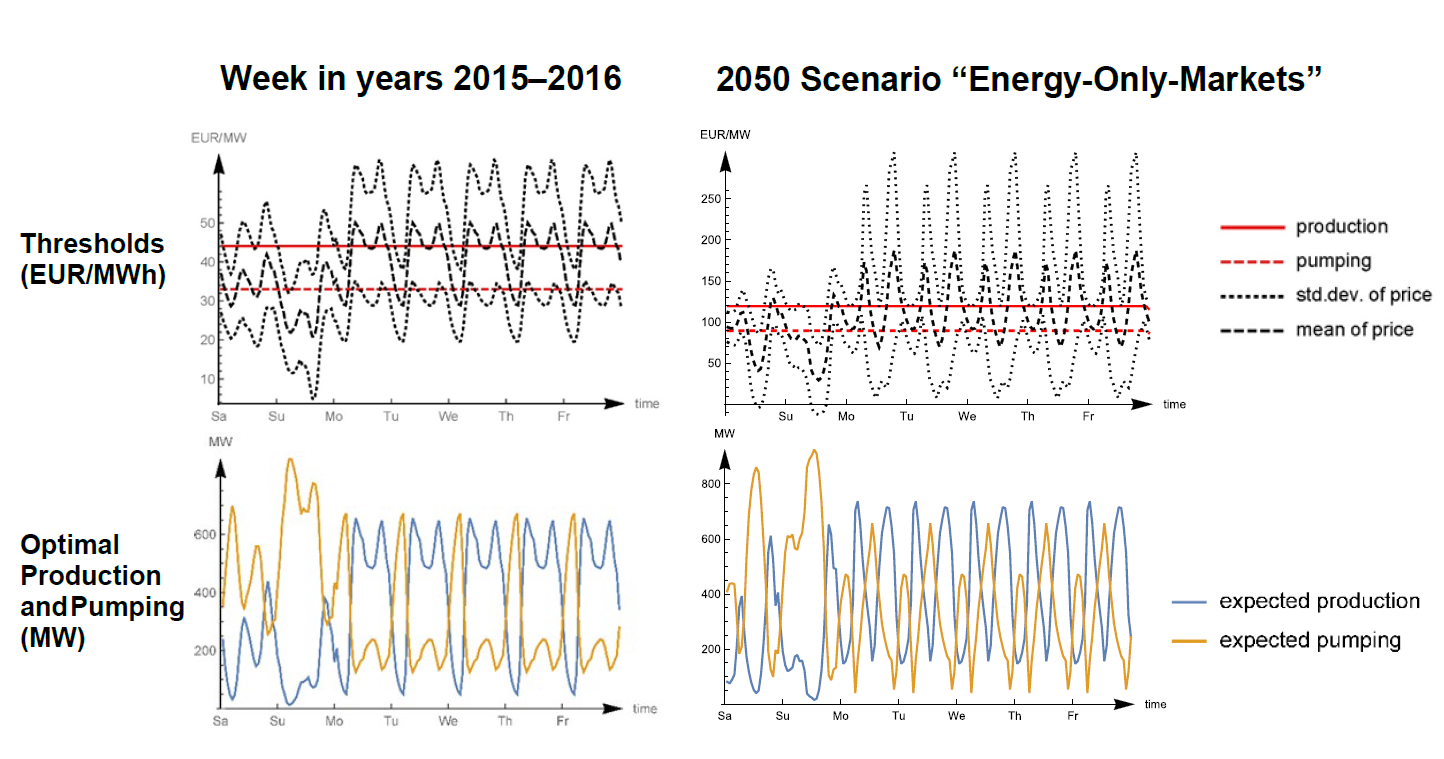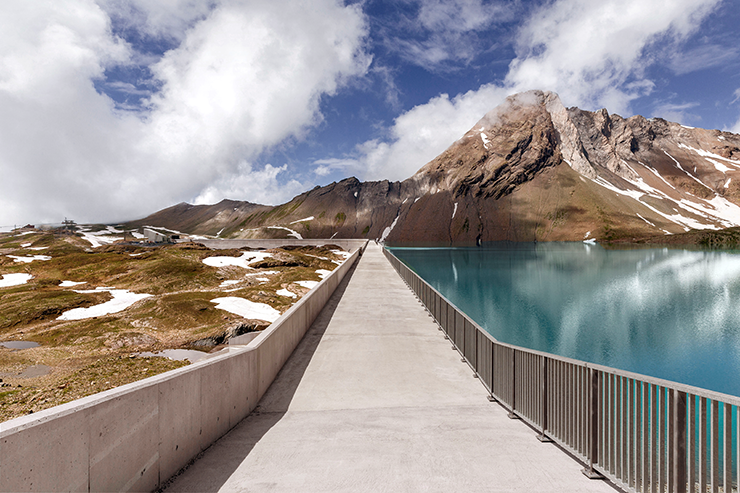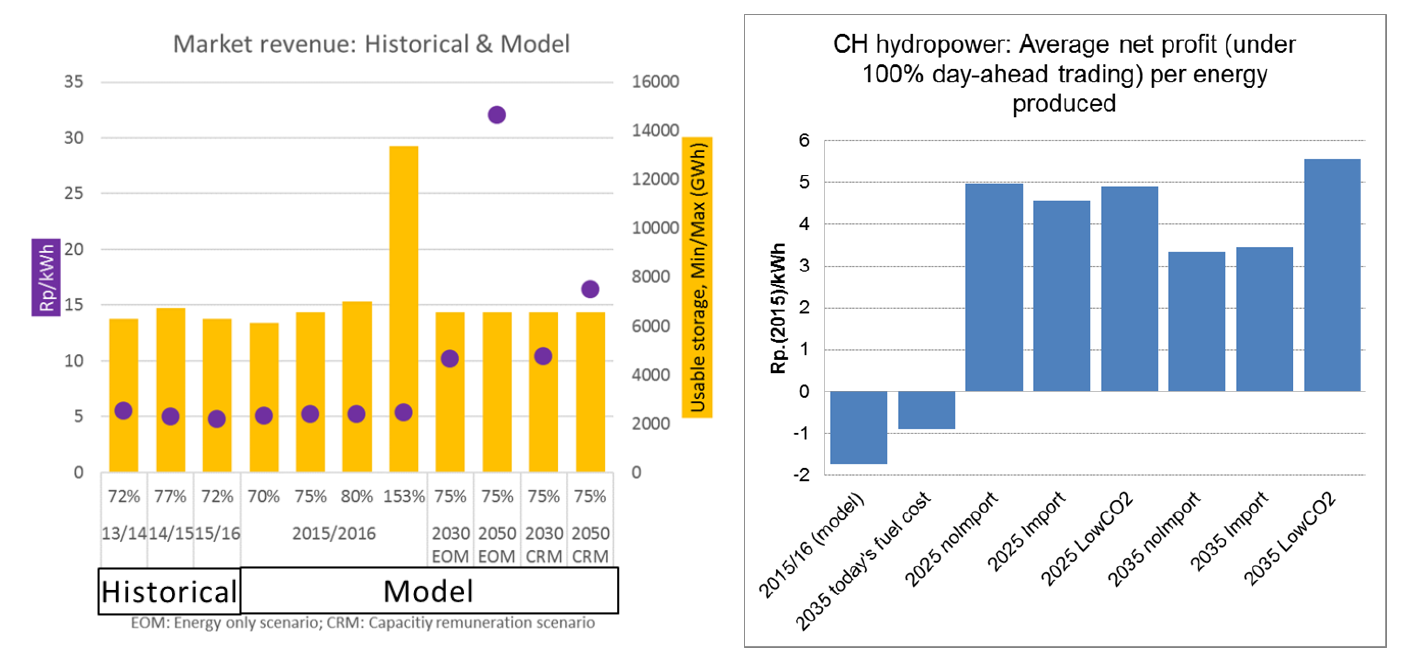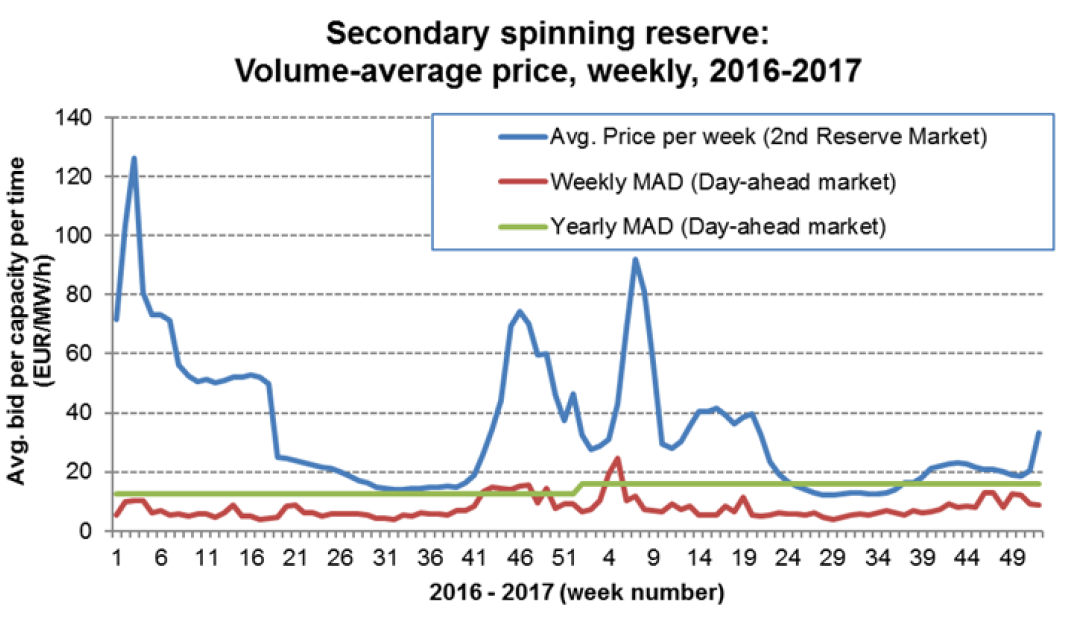Price-driven dispatch of hydropower
On the wholesale electricity markets, Swiss hydropower is mainly a price-taker. In the last decade, market prices in Switzerland decreased, which lead to drops in market revenues. The energy economics group of the Paul Scherrer Institute evaluated the possible prospects of market revenues under future price scenarios to assess possible profitability ranges of Swiss hydropower.
The operation of Swiss stored hydropower in a market environment is a complex task: The dispatch, i.e. the decision when to generate power and when to pump-up water (in case of pumped-storage), has to be optimized against the market prices under many side constraints. The market prices change on an hourly (or even sub-hourly) time scale, and the storage level is also changing by natural water flows. Moreover, stored hydropower plants in Switzerland serve as seasonal long-term storage. The decision to dispatch water in the next hour should optimally be made considering the opportunity to dispatch alternatively in later hours and taking into account the available water and likely future price ranges.
In our project in the SCCER-SoE, the purpose of price-driven dispatch optimization is to determine possible ranges of future market revenues by using accessible, well-documented modelling. The hourly dispatch is optimized up to a time horizon of a year, taking into account both hourly and seasonal price variations. We base the stochastic modelling on the statistical properties of electricity prices and give examples of a pumped-storage plant, the stored hydropower in the context of EU’s price determinants, and spinning reserve provision.
First example: Swiss hydropower may generate higher profits in 2050
As a first example, we optimized the 1 GW pumped-storage turbines of Muttsee, which are part of the Linth-Limmern complex, under two future price scenarios. The scenarios assume a large renewable deployment as in the Energy Strategy of the Swiss Federal Office of Energy (SFOE): The EOM (“energy-only-market”) scenario has no market mitigation measures against price peaks from intermittent renewables, whereas, for CRM (“capacity remuneration mechanisms”), such measures are in place. As a result, in the year 2050, higher price levels are expected in both scenarios. This suggests that Swiss hydropower, which is a price-taker, can have significantly higher profits in the long-term.
We also found that that a (hypothetical) increase in Swiss storage volume without increasing inflow has a negligible impact, which shows that just increasing damn heights without getting more water into the lakes may not always be optimal. Results also show that future prices are likely more volatile in the considered scenarios in 2050, which means that the pump-release cycle-frequency per day will almost double, which impacts turbine wear-down and plant efficiency (see Fig. 1). Because we expect the increase in price variation to come only relatively late in the years 2035–2050, pumped-storage plants may not yet increase their market revenues very early, despite increasing price levels.

Figure 1: Price distribution and dispatch in the example of the pumped-storage plant Muttsee: Today’s optimal operation pattern and under future renewable scenarios.
Second example: Short- and mid-term analysis for the European context
In the European context and for the Swiss stored-hydropower in aggregate, we also analyzed similar scenarios for the short- and mid-term years 2025 and 2035: Scenarios with
- annual imports allowed (yes/no);
- “low carbon” (i.e. high CO2 price of SFOE’s NEP scenario); and
- today’s fossil fuel costs prevailing in the future.
The analysis shows that hydropower plants may not be profitable in case today’s fuel costs prevail (e.g. CO2 price ~ 10 EUR/tCO2 in the European ETS). On the other hand, hydropower can become (very) profitable under long-term high gas (and CO2) prices, because gas plants in the surrounding countries of Switzerland are expected to be important price setters.
Third example: Additional revenue for service provisions might stay limited
Balancing service provision is an additional source of income for flexible hydropower. We analyzed secondary spinning reserve in Switzerland. It turns out that a fair spinning-reserve power-price is entirely determined by the (hourly) spot-price variations, with the available water storage volume as an additional parameter. Hence, likely higher service provision prices in the future are related to increased market price variations. This suggests that the additional revenue from such services for peak-hydropower stays limited (relative to the energy-only-market). Estimated lower price ranges are indicated in Fig. 3, and an upper price range under moderate lower-water reservoir assumption is approximately at merely 20 EUR/MW per hour on average in the considered time frame of 2016–2017. This indicates that the auctioned prices might have been relatively high.
Blog Article
This article is now availabe in the SCCER-SoE blog in German, French and English with a more detailed biography of the author.
Publications
Densing, M. (2020): The value of flexible selling: Power production with storage for spinning reserve provision. European Journal of Operational Research. 281, p. 141–151.
Panos, E. & Densing, M. (2019): The future developments of the electricity prices in view of the implementation of the Paris Agreements: Will the current trends prevail, or a reversal is ahead? Energy Economics. 84, p. 1–17.
Densing, M., Ramachandran, K., Panos, E., Kober, T. (2018): Long term role of Swiss hydropower from an energy systems and market perspective. Paul Scherrer Institute (PSI), AES/VSE PSEL research (Association of electricity suppliers of Switzerland).
Zimmermann, F., Densing, M. et al. (2018): Impact of different market designs in the CWE market area on electricity prices and on the competitiveness of Swiss hydropower (PowerDesign). SFOE-EWG research programme, Swiss Federal Office of Energy (BFE), ARAMIS Swiss Federal Research Database.
Panos, E., Densing, M., Schmedders, K. (2017): Oligopolistic Capacity Expansion with subsequent Market Bidding (OCESM). SFOE-EWG research programme, Swiss Federal Office of Energy (BFE), ARAMIS Swiss Federal Research Database.



